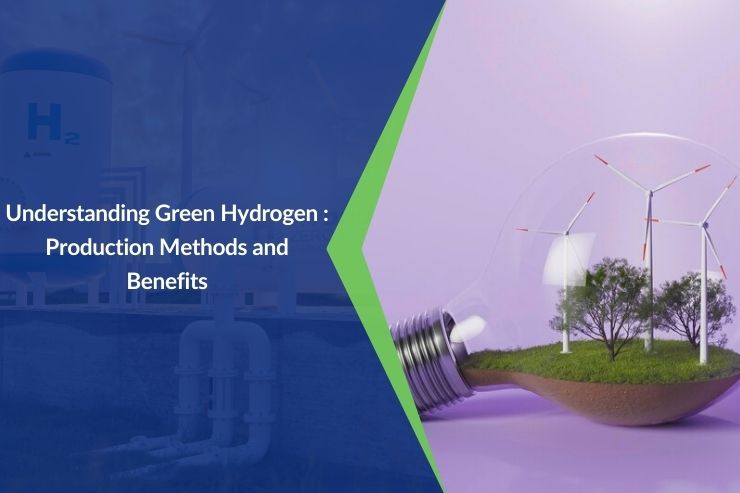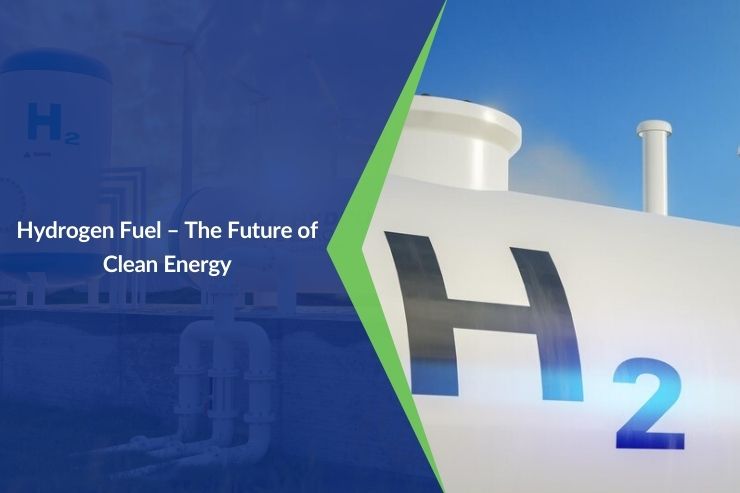Introduction to Green Hydrogen Plant
Green hydrogen is attracting more attention as a player in the transition to eco-friendly energy. It refers to hydrogen generated by splitting water through electrolysis with energy sources such, as wind, solar and hydroelectric power. Green hydrogen is praised for its potential to greatly reduce carbon emissions. Its significance lies in offering a versatile and sustainable energy solution. A green hydrogen plant facility serves as the setup where this conversion takes place utilising technology to separate water molecules into hydrogen and oxygen without leaving any carbon footprint behind.
How Green Hydrogen Plant Works
- Electrolysis Process
The core of a green hydrogen plant is the electrolysis process. Electrolysis involves passing an electric current through water to separate it into hydrogen and oxygen. This process takes place in an electrolyser, which consists of two electrodes (an anode and a cathode) and an electrolyte. When electricity, sourced from renewable energy, is applied, water molecules (H2O) are split into oxygen (O2) at the anode and hydrogen (H2) at the cathode.
- Role of Renewable Energy Sources
Green hydrogen production relies on energy sources, like panels, wind turbines and hydroelectric plants to power the electrolysis process. This sustainable approach ensures that the production is environmentally friendly and doesn’t contribute to greenhouse gas emissions. The use of renewable energy makes green hydrogen a viable and eco-friendly substitute, for fossil fuels.
- Efficiency and Sustainability Aspects
Producing hydrogen efficiently is crucial. Progress in technology is constantly enhancing the effectiveness of the electrolysis process making it more economical and adaptable. Sustainability is not only attained through energy usage but also by reducing water consumption and optimising the entire production process. This leads to a loop where the oxygen by-product can be used in industrial applications, increasing environmental advantages even further.
Benefits of Green Hydrogen Plant
- Environmental Advantages
Green hydrogen plants offer substantial environmental benefits. The primary advantage is the significant reduction in carbon emissions, as the production process does not involve any fossil fuels. This makes green hydrogen a key player in combating climate change and reducing air pollution.
- Reduction in Carbon Footprint
Using hydrogen can significantly decrease the impact of industries that typically depend on fossil fuels. For example, areas such as transportation, heavy industry and power generation have the potential to shift towards hydrogen, thereby lowering their carbon emissions and supporting sustainability objectives.
- Contribution to Energy Security
Green hydrogen enhances energy security by providing a stable and sustainable energy source. Unlike fossil fuels, which are subject to geopolitical tensions and market volatility, green hydrogen can be locally produced, reducing dependence on imported energy and enhancing national energy resilience.
Green Hydrogen Plant in India
- Current State and Future Prospects
India is dedicatedly working towards advancing hydrogen technology in line with its pledge to sustainable energy. It has kickstarted initiatives to build hydrogen facilities, making use of its extensive renewable energy reserves. These endeavors are poised to establish India as a player, in the arena of green hydrogen production.
- Key Projects and Initiatives
Significant projects are at the forefront of India’s green hydrogen initiatives, focusing on creating a robust infrastructure for hydrogen production, storage, and distribution. Collaborations with international partners are further enhancing technological capabilities and accelerating project timelines. These efforts are playing a pivotal role in advancing the country’s green hydrogen sector and positioning it as a key player in the global renewable energy landscape.
- Government Policies and Support
The government of India has implemented policies and incentives to encourage the growth of hydrogen. This includes providing subsidies for integrating energy investing in research and development and establishing regulatory conditions. These efforts are essential, for overcoming obstacles and encouraging the use of hydrogen technology.
Renewable Hydrogen and Its Applications
- Uses in Various Industries
Renewable hydrogen, or green hydrogen, has a wide range of applications across various industries. In transportation, it powers fuel cell vehicles, offering a zero-emission alternative to traditional internal combustion engines. In the energy sector, green hydrogen can be used for electricity generation and grid balancing, providing a reliable backup for intermittent renewable sources. Additionally, it plays a vital role in industrial processes such as steel production and ammonia synthesis, replacing carbon-intensive methods.
- Case Studies of Successful Implementations
Numerous real-life examples showcase the adoption of eco-hydrogen technology. For example, nations such as Germany and Japan have led the way in hydrogen initiatives incorporating eco-hydrogen into their energy and transport infrastructures. These initiatives illustrate the viability and advantages of eco-hydrogen presenting themselves as blueprints, for countries to follow suit.
- Comparison with Other Types of Hydrogen
Green hydrogen stands out when compared to other types of hydrogen, such as grey and blue hydrogen. Grey hydrogen is produced from natural gas, resulting in significant CO2 emissions, while blue hydrogen involves carbon capture and storage to mitigate emissions. However, green hydrogen, produced entirely from renewable sources, offers the most sustainable solution, with zero carbon emissions throughout the production process.
Leading Green Hydrogen Plant Developers
- Major Global and Indian Developers
Leading developers in the green hydrogen sector include international giants like Siemens, who are at the cutting edge of green hydrogen technology. These companies are driving advancements and setting benchmarks for the industry.
- Innovations and Technological Advancements
Technological innovations are central to the growth of green hydrogen. Advancements in electrolyser efficiency, renewable energy integration, and hydrogen storage solutions are making green hydrogen more viable and cost-effective. These innovations are essential for scaling up production and meeting global energy demands sustainably.
- Key Partnerships and Collaborations
Collaborations between industry leaders, governments, and research institutions are crucial for advancing green hydrogen technology. Partnerships enable the sharing of knowledge, resources, and expertise, accelerating the development and deployment of green hydrogen solutions.
Challenges and Solutions in Green Hydrogen Plant Development
- Technical and Economic Challenges
The development of green hydrogen plants faces several technical and economic challenges. High initial capital costs, efficiency losses in the electrolysis process, and the need for extensive infrastructure are significant hurdles. Additionally, the economic viability of green hydrogen depends on the cost of renewable energy and advancements in technology.
- Solutions and Advancements in Technology
To overcome these challenges it’s essential to focus on research and innovation. Advances in technology that improve energy efficiency and developments in hydrogen storage, play a crucial role. Additionally, government support, through incentives and policies is crucial to enable hydrogen to be economically competitive.
- Future Outlook for Green Hydrogen Plants
The future outlook for green hydrogen is promising. As technology advances and economies of scale are achieved, the cost of green hydrogen production is expected to decrease. This will facilitate its widespread adoption, positioning green hydrogen as a cornerstone of the global energy transition towards sustainability.
Conclusion
In a nutshell, green hydrogen facilities are leading the charge in energy advancement providing an eco-effective answer to the world’s energy requirements. The progress of hydrogen technology in both India and worldwide is laying the groundwork for a more robust energy landscape. Ongoing investments, progress and favourable policies are crucial for unleashing the capabilities of green hydrogen guaranteeing its place in the global shift, towards renewable energy sources.
Frequently Asked Questions
How Sustainable is Green Hydrogen Production?
Green hydrogen production is highly sustainable as it relies on renewable energy sources like wind and solar power. The process emits no greenhouse gases, making it an environmentally friendly alternative to fossil fuels.
What Role Do Renewable Energy Sources Play in Green Hydrogen Production?
Renewable energy sources are critical in green hydrogen production, providing the necessary electricity for the electrolysis process. By using renewable energy, the entire production chain remains carbon-free, contributing to a sustainable energy system.
What are The Economic Benefits of Investing in Green Hydrogen Plants?
Investing in green hydrogen plants offers several economic benefits, including job creation, energy security, and the development of a sustainable industrial sector. It also reduces reliance on fossil fuels, mitigating the economic impact of volatile fossil fuel markets.
How Does Green Hydrogen Compare to Conventional Hydrogen in Terms of Environmental Impact?
Green hydrogen is superior to conventional hydrogen in terms of environmental impact. Conventional hydrogen production methods, such as steam methane reforming, result in significant CO2 emissions. In contrast, green hydrogen production is carbon-free, offering a sustainable alternative.
What are The Key Challenges Hindering The Widespread Adoption of Green Hydrogen Technology?
Key challenges include high initial costs, technological limitations, and the need for extensive infrastructure. Overcoming these challenges requires continuous innovation, government support, and strategic investments.
How are Governments Supporting The Development of Green Hydrogen Infrastructure?
Governments are supporting green hydrogen development through policies, subsidies, and funding for research and development. These measures are crucial in reducing costs, advancing technology, and creating a favourable regulatory environment for green hydrogen adoption.
What are The Potential Future Advancements in Green Hydrogen Technology?
Future advancements in green hydrogen technology include improved electrolyser efficiency, enhanced hydrogen storage solutions, and the integration of advanced renewable energy systems. These advancements will make green hydrogen more cost-effective and scalable, facilitating its widespread adoption.
The development of green hydrogen plants marks a significant step towards a sustainable energy future. By harnessing the power of renewable energy, green hydrogen offers a clean, efficient, and versatile solution to the world’s energy challenges. With continued innovation and support, green hydrogen will play a pivotal role in the global transition to renewable energy.









